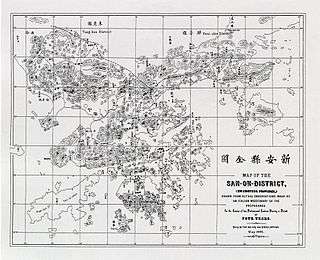Bao'an County
| Bao'an County 宝安县 | |||||
| County of China | |||||
| |||||
| History | |||||
| • | Established | 331 | |||
| • | Disestablished | 1979 | |||
| Today part of | | ||||
| Bao'an County | |||||||||||||||||||
| Simplified Chinese | 宝安县 | ||||||||||||||||||
|---|---|---|---|---|---|---|---|---|---|---|---|---|---|---|---|---|---|---|---|
| Traditional Chinese | 寶安縣 | ||||||||||||||||||
| Postal | Poon County | ||||||||||||||||||
| |||||||||||||||||||
| Xin'an County | |||||||||||||||||||
| Simplified Chinese | 新安县 | ||||||||||||||||||
| Traditional Chinese | 新安縣 | ||||||||||||||||||
| Postal | Sunon County | ||||||||||||||||||
| Literal meaning | New peace | ||||||||||||||||||
| |||||||||||||||||||
| This article is part of a series on the |
| History of Hong Kong |
|---|
 |
| Timeline |
| By topic |
|
Bao'an County (simplified Chinese: 宝安县; traditional Chinese: 寶安縣), formerly named Xin'an County was a historic county in South China. It includes the city of Shenzhen and Hong Kong. For most of its history, the administrative center of the county was in Nantou.
During the time of the Three Kingdoms, the later Bao'an County, along with Dongguan and Boluo counties, formed a single large district with the name Boluo (博羅).[1]
In 331, the Eastern Jin Dynasty established Bao'an County, one of six counties under Dōngguān (東官) Prefecture. This prefecture's area included modern Shenzhen and Dongguan.[2] In the second year of the Zhide of Suzong under the Tang Dynasty (757 AD), Dōngguān was renamed to Dōngguǎn (東莞).

In the 27th year of Hongwu Emperor's (1368–1399, founder of the Ming dynasty) reign, Hongwu appointed an officer with the title Shou-yu-suo (Chinese: 守御所; literally: "Protector of the region") to protect the local population from robbers and vagabonds which increasingly infested the district.[1]
In 1573, the first year of the reign of Wanli of the Ming Dynasty, Xin'an County (sometimes referred to as district) was established as a separate administrative division of Guangzhou Prefecture. The area was then separated from the old Dongguan County due to military reasons.[3]
.png)
Under the Qing Dynasty, Xin'an County was one of the fourteen districts under the department of Guangdong. During the Great Clearance (1661–1669), most of Xin'an County was affected by the coastal evacuation. However Xin'an ceased to be a separate administrative county by the 5th year of Kangxi (1666), and the areas not affected by the evacuation were temporarily absorbed into the adjoining Dongguan County until the lift of the ban in 1669.[3] From 1842 to 1898, 1055.61 km2 out of 3076 km2 of Xin'an County was ceded to the United Kingdom to form Hong Kong.[2]
After the founding of the Republic of China in 1913, the name of Xin'an was changed back to Bao'an.[2]
In 1979, Bao'an County was renamed Shenzhen City (深圳市) and became a Special Economic Zone.
Study Area
Study Area Shenzhen is a rapidly developing city in Guangdong province located at the mouth of the Pearl River Delta next to Hong Kong. It is regarded as an exemplar of China’s urbanisations and shares many of the environmental concerns mirrored by rapidly developing cities around the world (Guneralp and Seto 2008). The study area is the Bao’an district of Shenzhen city (Fig. 1). Bao’an district used to be a part of the former Bao’an county. Since the Shenzhen special economic zone was founded in 1980, Bao’an county has been governing the remainder of Shenzhen city. In 1993, Bao’an county was upgraded to a district of Shenzhen, covering 733 km2 of terrestrial land. It consists of the Xixiang, Fuyong, Shajing, Songgang, Gongming, Longhua, Guanlan, Xinan and Guangming subdistrict offices, of which Guangming and Longhua were upgraded to districts in 2007 and 2011, respectively. For data processing convenience, the study area assumed the same coverage from 1988 to 2014. Bao’an District experienced a rapid urbanisation process from 1988 to 2014. It developed into a modern industrialised area from an agriculture-dominated area in the early 1980s. The permanent resident population increased to 4.675 million in 2014 from 0.442 million in 1988, while at the same time, the number of immigrants increased to 3.955 million in 2014 from 0.435 million in 1988. The gross domestic product increased to 449.898 billion yuan in 2014 from 1.512 billion yuan in 1988 (Shenzhen Bao’an district 2015). The urbanisation trend is forecasted to continue through 2030 (Güneralp and Seto 2008). Bao’an has a tropical seasonal climate characterised by being warm and wet year round, with sunny weather and rich precipitation in alternating dry and wet seasons. Most of the rainfall takes place in the wet season, usually from May to September.[4]
See also
References
Citations
- 1 2 Krone 1859.
- 1 2 3 Brief History of Shenzhen Archived April 16, 2008, at the Wayback Machine., Shenzhen Government official website.
- 1 2 James Hayes: "The Hong Kong Region: Its Place in Traditional Chinese Historiography and Principal Events Since the Establishment of Hsin-an County in 1573", in Journal of the Royal Asiatic Society Hong Kong Branch, Vol. 14, 1974. pp.108-135
- ↑ Tianhong Li1,2 ● Fengjiao Bai2 ● Peng Han1,2 ● Yuanyan Zhang2 (2016). Non-Point Source Pollutant Load Variation in Rapid Urbanization Areas by Remote Sensing, Gis and the L-THIA Model: A Case in Bao’an District, Shenzhen, China. New York. pp. 1 and 874 andf 875.
Sources
- Mr. Krone (1859). A Notice of the Sanon District, Transactions, Vol. 6, pp. 71–105, Hong Kong (1859).
.svg.png)